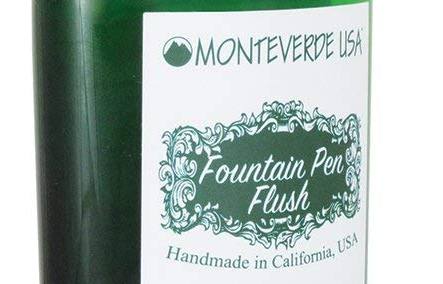Cleaning a fountain pen is best done with warm water and a few extremely affordable tools, but stubborn inks and vintage pens with dried ink can require a tougher cleaner. In this case you might be tempted to buy a pen flush, like the popular Monteverde Fountain Pen Flush. I’ve certainly bought my share of pen flush liquids, but it’s worth knowing that you can make your own as well.
Of course, nothing will beat an ultrasonic cleaner, but those can be pricey and intimidating, so we’ll stick with flush liquid for now.
And, as noted, cleaning with water is safe and effective. It’s what I recommend if you truly cannot accept any risk to your pens. Water is limited in its cleaning power though, so if you want your pens to be immaculately clean, something more can be necessary.
Flush, Don’t Soak
Fountain pen flush, especially those with ammonia or similar product in it, are meant to be flushed through pen. Often people will want to soak their fountain pens to get a deeper clean, but you should not do this with fountain pen flush with the exception of a short timeframe, like 15 minutes. All major flush manufacturers will stress not to let a pen sit in pen flush for any length of time.
So, if you want to clean a pen with soaking, do it with water alone.
Even with this quick flushing action, don’t use any sort of flush with a pen made from celluloid or a vintage pen made before 1950 (or so). The 50s is just a general line of when materials changed and more modern rubbers and plastics will be better with cleaners.
DIY Pen Flush Ingredients
Most people in the fountain pen community swear by this recipe:
- 9 parts water
- 1 part household (5%) ammonia
- 4 (or less) drops of household dish soap, the plainest possible (Dawn for example)
Put them in all in a container, mix the ingredients or give the mixture a shake and then you are set. Label the container and you’ll have huge amounts of pen flush for a fraction of the price of the commercial stuff.
Never mix bleach (or something containing bleach) with ammonia. It’s dangerous.
Alternative Formula
- 9 parts water
- 1 part household (5%) ammonia
- 8 drops of dishwasher detergent (the plain, non-citrus stuff)
Dishsoap can be a little clingy so some people prefer dishwasher detergent. Finding an appropriate dishwasher detergent can be tough, so look for something plain and non-concentrated.
How To Use Your Pen Flush
With any fountain pen flush you’ll want to make sure to leave it in the pen for a limited amount of time, usually under 30 minutes.
The basic cleaning process should be to flush the pen with warm water, then use the pen flush, and then fully flush it with water again to remove any of the flush mixture. You’ll want to do this final flush a few times in order to fully clean out the pen.
Any any old, delicate, or celluloid pens I’d recommend only using water. The ammonia can damage older pen parts, like delicate seals and celluloids.
Notes On The Ingredients
Household ammonia can be hard to find, but it can normally be located in some larger supermarkets (main stream ones, not Whole Foods), in pharmacies, and in hardware stores. You’ll get way more then you need, and if you don’t like storing ammonia in your home this will present you with a bigger problem then finding it. This is one reason why many people simply get the pen flush!
Make sure you buy normal 5% solution ammonia, not something stronger or more industrial. This will keep the flush’s concentration of ammonia to under 0.5%, which should prevent the chance of pen damage.
If you don’t want to store ammonia or you can’t find it, you can remove it from the recipe and simply use water and a few drops of dish soap. Don’t add extra dish soap and try to overcompensate for the lack of ammonia, as they serve different purposes. The ammonia will cut through dried ink better than other cleaning liquids and it will help clear up old plastics that have gone cloudy as well as stubborn old feeds.
The downside of the ammonia is that it can make older plastics brittle and damage older sacs/seals.
A typical commercial pen flush will contain: distilled water, ammonium hydroxide, and surfactants. This is essentially what this recipe is following, albeit with household ingredients.
Some people recommend India ink cleaners, like Koh-i-noor Rapid-o-eaze, but these can be even less delicate than the cleaning solution above. We’ve tested the Speedball cleaner and it’s similarly harsh but effective for some types of fountain pen ink. It’s added risk and noxiousness is not worth the limited additional cleaning power over a homemade cleaner or commercial pen flush like those from Platinum or Monteverde.
